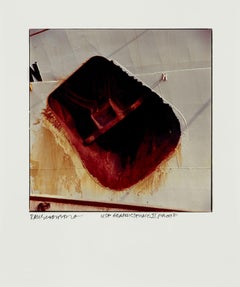Study For Chinese Summerhall
Recent Sales
21st Century and Contemporary Abstract Still-life Photography
Photographic Paper
1980s Modern Landscape Photography
Paper, Photographic Paper, Color
1980s Modern Landscape Photography
Paper, Photographic Paper, Color
Robert Rauschenberg for sale on 1stDibs
Robert Rauschenberg was one of the preeminent American artists of the 20th century, occupying a singular position that straddled the Abstract Expressionist and Pop art movements, drawing on key elements of each. An artistic polymath equally adept at painting, collage and silkscreening, Rauschenberg is best known for for the complex assemblages of found objects he termed “combines.”
Rauschenberg was born in Port Arthur, Texas, in 1925. He first began to seriously consider a career in art in 1947, while serving in the U.S. Marines. After leaving the service, he briefly studied art in Paris with support from the G.I. Bill, then moved to North Carolina to attend Black Mountain College, home to a flourishing cross-disciplinary art community. Among his peers there were choreographer Merce Cunningham and composer John Cage, both of whom became friends and artistic collaborators.
Relocating to New York in the mid-1950s, Rauschenberg was initially put off by what he perceived as the self-seriousness of the adherents of Abstract Expressionism, then the dominant movement in the New York art world. Like Andy Warhol and Roy Lichtenstein, Rauschenberg was drawn to the visual landscape of popular culture and mined its imagery for inspiration. He used unorthodox materials like house paint and tried novel techniques in his studio like running paper over with a car whose wheels he had inked. Shortly after his inaugural solo exhibition at Leo Castelli Gallery, which featured paintings and drawings, he pivoted to a new format, creating his first found-object combines, which became his signature. The most famous of these is the 1959 Monogram in which a taxidermied goat is surrounded by a car tire, recalling the way a person’s initials are interwoven in the design referred to by the title.
Later in the 1960s, Rauschenberg turned his attention to silkscreening, creating prints that feature iconic figures of the day, very much in line with the style and content of Pop art. One such work, 1965's Core, which was created to commemorate the Congress of Racial Equality, combines photographs of President Kennedy, an unidentified Native American man, and a statue of a Civil War soldier with images of highways, amusement parks, street signs, and other features of the built environment. A circular color-test wheel sits at the composition’s formal core, reflecting the work’s commentary on race and ethnicity.
Throughout the 1960s and ‘70s, Rauschenberg experimented with printing on unusual materials, such as Plexiglas, clothing and aluminum. Venturing even further afield, he created performance works, such as his 1963 choreographed piece “Pelican” and the 1966 film Open Score. In 1998, the Guggenheim Museum presented a large and comprehensive retrospective of Rauschenberg’s work, highlighting his influence on American art in the second half of the 20th century.
Find original Robert Rauschenberg art for sale on 1stDibs.
Finding the Right photography for You
Find a broad range of photography on 1stDibs today.
The first permanent image created by a camera — which materialized during the 1820s — is attributed to Joseph Nicéphore Niépce. The French inventor was on to something for sure. Kodak introduced roll film in the 1880s, allowing photography to become more democratic, although cameras wouldn’t be universally accessible until several decades later.
Digital photographic techniques, software, smartphone cameras and social-networking platforms such as Instagram have made it even easier in the modern era for budding photographers to capture the world around them as well as disseminate their images far and wide.
What might leading figures of visual art such as Andy Warhol have done with these tools at their disposal?
Today, when we aren’t looking at the digital photos that inundate us on our phones, we look to the past to celebrate the photographers who have broken rules as well as records — provocative and prolific artists like Horst P. Horst, Lillian Bassman and Helmut Newton, who altered the face of fashion and portrait photography; visionary documentary photographers such as Gordon Parks, whose best-known work was guided by social justice; and pioneers of street photography such as Henri Cartier-Bresson, who shot for revolutionary travel magazines like Holiday with the likes of globetrotting society lensman Slim Aarons.
Find photographers you may not know in Introspective and The Study — where you’ll read about Berenice Abbott, who positioned herself atop skyscrapers for the perfect shot, or “conceptual artist-adventurer” Charles Lindsay, whose work combines scientific rigor with artistic expression, or Massimo Listri, known for his epic interiors of opulent Old World libraries. Photographer Jeannette Montgomery Barron was given a Kodak camera as a child. Later, she shot on Polaroid film before buying her first 35mm camera in her teens. Barron's stunning portraits of Jean-Michel Basquiat, Warhol and other artists chronicle a crucial chapter of New York’s cultural history.
Throughout the past two centuries, photographers have used their medium to create expressive work that has resonated for generations. Shop a voluminous collection of this powerful fine photography on 1stDibs. Search by photographer to find the perfect piece for your living room wall, or spend some time with the work organized under various categories, such as landscape photography, nude photography and more.

